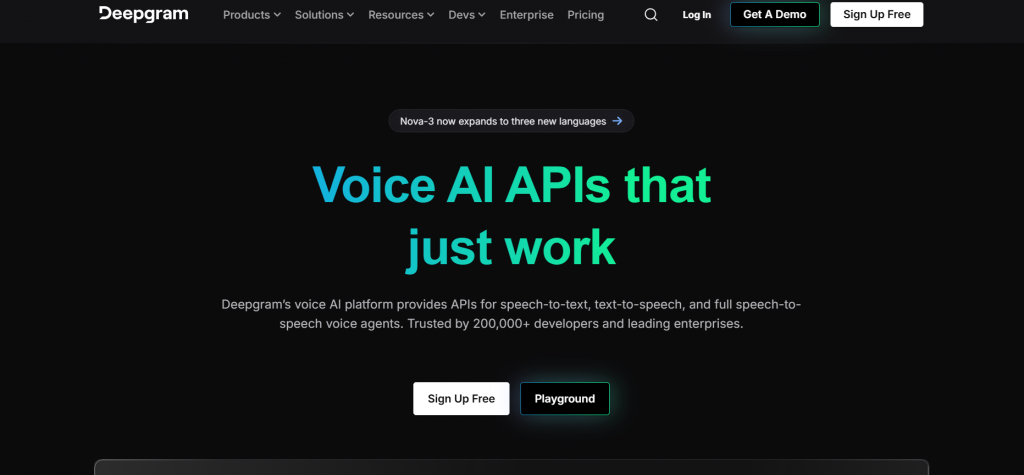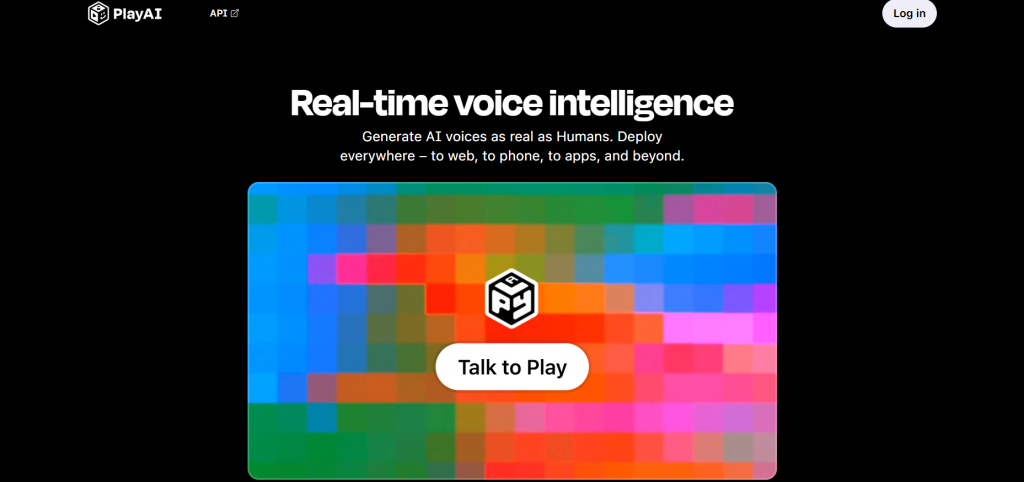For developers in the voice AI space, the architecture of an application often hinges on one critical question: What is the most important part of the user experience? Is it the speed and accuracy with which your application can listen and understand, or the quality and realism with which it can speak and respond? This question leads directly to a crucial platform comparison: Deepgram vs Play AI.
One is a foundational AI company celebrated for its blistering speed and precision in speech-to-text. The other is a leader in creating ultra-realistic, emotionally resonant synthetic voices. For a developer, choosing between them is not about picking a “better” tool, but about selecting the right foundational component for the job at hand.
This guide provides a direct, developer-focused comparison of Deepgram vs Play AI, breaking down their core strengths, API design, and ideal use cases to help you make the most informed decision for your project.
Table of contents
What is Deepgram?
Deepgram is an AI company that has built its reputation on a single, powerful premise: providing the fastest, most accurate, and most scalable speech-to-text (STT) on the market. They are an API-first company that treats automatic speech recognition as a core infrastructure problem to be solved with end-to-end deep learning.

Features of Deepgram AI
- Blazing Speed: It is engineered for real-time streaming, delivering transcripts with incredibly low latency, which is critical for interactive applications.
- High Accuracy: Their models are known for their precision, even in challenging audio environments with background noise or multiple speakers.
- Powerful Features: The API is packed with developer-centric features like speaker diarization, smart formatting (for numbers, dates, etc.), topic detection, and Personally Identifiable Information (PII) redaction.
- Simple API: Integrating Deepgram is straightforward. You send an audio stream or file and get back structured, transcribed data.
Developers choose Deepgram when the primary function of their application is to listen and understand spoken language with maximum speed and reliability.
What is Play AI (Play.ht)?
Play AI, widely known as Play.ht, is a leader in the world of high-fidelity Text-to-Speech (TTS) synthesis. Their core mission is to create AI voices that are indistinguishable from human speech, complete with emotion, intonation, and personality. While they offer a conversational API, their foundational strength and key differentiator is the stunning quality of their voices.

Features of Play AI
- Ultra-Realistic Voices: It provides access to a library of voices that can convey a wide range of emotions, making them perfect for engaging and immersive user experiences.
- Voice Cloning: The platform offers powerful voice cloning capabilities, allowing you to create a unique and consistent brand voice for your application.
- High-Quality Audio Generation: The API is simple to use for generating high-quality audio files from text, giving you fine-grained control over the final output.
- Conversational API: They have built upon their world-class TTS to offer an API for real-time conversations, designed to bring that same level of vocal quality to interactive agents.
Developers choose Play AI when the primary function of their application is to speak and deliver an experience where the voice’s personality and quality are paramount.
Also Read: Programmable Voice APIs Vs Cloud Telephony Compared
Deepgram vs Play AI: A Developer-Focused Comparison
Let’s break down the Deepgram vs Play AI choice from a technical, developer-centric perspective.
| Feature | Deepgram | Play AI (Play.ht) |
| Primary Function | Speech-to-Text (STT) / Audio Understanding | Text-to-Speech (TTS) / Voice Synthesis |
| Core Strength | Speed, Accuracy, Scalability | Realism, Emotion, Voice Cloning |
| API Design | API-first, focused on transcription endpoints | API-first, focused on audio generation endpoints |
| Developer Task | Getting text data from audio | Getting audio data from text |
| Use Case Focus | A foundational component for “listening” | A foundational component for “speaking” |
| Real-Time Ability | Best-in-class for real-time transcription | Offers real-time conversational API |
Why Is FreJun AI Different?

When building with foundational components like Deepgram and Play AI, a critical piece is often missing: the telephony and voice infrastructure that connects these AI models to a real phone call. This is the specific, focused problem FreJun AI solves. We are not an STT or TTS provider.
Instead, we provide the core infrastructure for real-time call streaming. Our philosophy, “We handle the complex voice infrastructure so you can focus on building your AI,” means we provide the reliable “plumbing” that allows developers to plug in best-in-class components like Deepgram for STT and Play AI for TTS to build a truly custom, high-performance voice stack.
Use Case Analysis: Choosing the Right Tool for the Job
The decision in the Deepgram vs Play AI debate becomes clear when you define your application’s core requirement.
Choose Deepgram for Listening-Intensive Applications
You should choose Deepgram when your application’s success depends on what it can hear and understand from an audio stream.
- Example Project: Building a real-time sales coaching tool that listens to live sales calls, transcribes them, and provides feedback to the sales manager.
- Why Deepgram is Developer-Friendly Here: The developer’s primary task is to get a fast, accurate transcript. Deepgram’s streaming API and speaker diarization are perfect for this. The quality of an AI-generated voice is not a factor in this application’s success.
Also Read: How To Lower Latency In Voice AI Conversations?
Choose Play AI for Speaking-Intensive Applications
You should choose Play AI when the user’s experience is defined by the voice they are hearing.
- Example Project: Creating an AI-powered meditation guide where the calming, reassuring, and human-like quality of the voice is the most important feature.
- Why Play AI is Developer-Friendly Here: The developer’s main job is to create a serene and immersive audio experience. Play AI’s simple API for generating high-fidelity, emotionally-aware audio is the ideal tool for this. The application is primarily speaking, not listening.
Conclusion
Ultimately, the Deepgram vs Play AI comparison is not about finding a single winner. It is about understanding that they are both exceptional, developer-friendly tools that serve as foundational components for different tasks. They are not competing; they are complementing.
Choose Deepgram when your application needs to listen. Its speed, accuracy, and robust feature set make it the developer’s choice for turning audio into actionable data.
Choose Play AI when your application needs to speak. Its stunningly realistic and emotive voices make it the developer’s choice for creating engaging and immersive audio experiences.
By identifying whether your application’s core function is to be a world-class listener or a world-class speaker, you can confidently choose the right tool and build a more powerful and effective voice AI application.
Also Read: SIP Trunking Providers vs Traditional Carriers: Which Is Better?
Frequently Asked Questions (FAQs)
Absolutely. For developers building a custom voice agent, using Deepgram for Speech-to-Text and Play AI for Text-to-Speech is a “best-of-breed” approach that can yield superior performance.
For the listening part of a real-time conversation, Deepgram’s low-latency streaming is industry-leading. For the speaking part, Play AI offers a conversational API. A complete agent needs both capabilities.
Play AI is the ideal choice for this, as it offers powerful voice cloning features that allow you to create a custom, proprietary voice.
No. Both are AI model providers that you access via an API. To connect your application to the telephone network to make and receive calls, you need a specialized voice infrastructure platform like FreJun AI.
